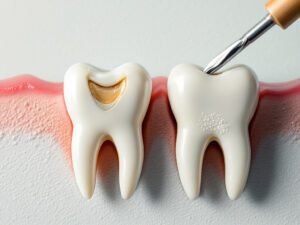With crown and bridge dentistry, you can restore damaged, decayed, or missing teeth with solutions that look and function like natural teeth. Whether you need a single crown after a root canal or a multi-unit bridge to fill gaps in your smile, these restorative options protect your oral health and boost your confidence. In this article, you’ll learn what crown and bridge dentistry involves, explore the different types and materials, understand the treatment process, and discover how to care for your new restorations. You’ll also compare alternative treatments and get tips on choosing the right provider for your smile.
Understand crown and bridge dentistry
What is crown dentistry?
A dental crown is a custom-made cap that fits over a weakened or damaged tooth. Crowns can cover cracks, reinforce decayed areas, improve appearance, and protect teeth after root canal therapy. They sit on top of your existing tooth or implant, restoring strength, shape, and function [1].
What is bridge dentistry?
A dental bridge replaces one or more missing teeth by anchoring artificial teeth (pontics) between crowns fitted on adjacent natural teeth or implants. Bridges restore chewing ability, speech, and prevent neighboring teeth from shifting out of alignment [2].
Key benefits
- Protects and strengthens damaged teeth
- Restores chewing and speaking function
- Prevents jawbone loss and teeth shifting
- Improves smile aesthetics and confidence
- Offers long-term durability with proper care
Explore crown types
All ceramic crowns
All-ceramic or porcelain crowns mimic natural enamel with lifelike translucency and colour. They’re biocompatible—ideal if you have metal allergies—and gentle on opposing teeth. However, they can be less durable than metal-based options for heavy grinders [3].
Porcelain fused metal crowns
Porcelain fused to metal (PFM) crowns combine a metal base for strength with porcelain overlay for aesthetics. They suit front and back teeth but may show a dark line at the gum margin over time [4].
Metal alloy crowns
Metal alloy crowns—made of gold or other alloys—are highly durable, resist wear, and rarely fracture opposing teeth. Their metallic colour makes them best for back molars where appearance is less critical [4].
Zirconia crowns
Zirconia crowns are metal-free, exceptionally strong, and biocompatible. Their high fracture resistance makes them ideal for molars that endure heavy chewing forces. Colour options are improving to enhance aesthetics [5].
Pressed ceramic crowns
Pressed ceramic crowns feature a hard inner core of ceramic and porcelain outer layers, achieving a natural look. They’re popular for their blend of strength and translucency [3].
Composite resin crowns
Composite resin crowns blend with surrounding teeth for a seamless appearance. They’re cost-effective but more prone to wear, staining, and fracture compared to ceramics or metals [4].
Same day crowns
Using CAD/CAM technology, same day crowns can be designed, milled, and placed in a single visit. Digital impressions eliminate the need for messy molds, and you leave with a finished crown in hours [3].
Compare bridge options
Here are four main bridge types, each suited to different situations:
| Type | Description | Ideal use | Pros | Cons |
|---|---|---|---|---|
| Traditional | Pontic supported by crowns on both sides | Healthy adjacent teeth | Strong, durable | Requires preparing two teeth |
| Cantilever | Pontic attached to one crowned tooth | Adjacent tooth on one side only | Less invasive than traditional | Puts stress on single support |
| Maryland | Resin-bonded pontic with metal or ceramic framework bonded to back of teeth | Front teeth with minimal stress | Conserves tooth structure, reversible | Less durable under heavy chewing |
| Implant-supported | Pontic anchored to dental implants instead of natural teeth | Jawbone with sufficient density | Preserves bone, doesn’t affect adjacent teeth | Requires surgery, longer healing time |
Most bridges last 5 to 15 years, and some may last even longer with diligent care [2].
See procedure steps
Initial consultation
At your first visit, your dentist reviews your medical history, examines your teeth, and takes X-rays. Together you’ll discuss goals, budget, and timelines. If you need a filling before a crown, your dentist may refer you to a tooth filling dentist.
Tooth preparation and impression
Your tooth is reshaped to make room for the crown. After numbing, your dentist takes an impression digitally or with traditional molds. For bridges, impressions capture both the abutment teeth and the gap.
Temporary restoration
A temporary crown or bridge protects the prepared teeth while your permanent restoration is crafted in a dental lab, typically over one to two weeks [6].
Final fitting and cementation
Your dentist removes the temporary restoration, checks fit, bite, and colour, then cements the permanent crown or bridge. Adjustments ensure comfort and proper alignment. If you’re having a crown placed after root canal therapy, learn more about root canal therapy.
Review material choices
Ceramic and porcelain
These materials provide the best aesthetics, matching the translucency of natural teeth. All-porcelain crowns are free of metal and suit those with allergies [5].
Metal alloys
Gold and other alloys offer unmatched strength and longevity. Metal crowns work well on chewing surfaces where durability outweighs appearance.
Composite and resin
Composite crowns blend easily with your smile but require more maintenance due to wear and staining.
Zirconia
Zirconia’s toughness rivals metal while offering a brighter colour option. It’s ideal for both crowns and implant-supported bridges.
Consider long term care
Oral hygiene routine
Brush twice daily with a soft-bristle brush and floss daily, sliding the floss under bridge pontics to remove plaque. Use an antibacterial mouthwash to curb bacteria.
Regular dental visits
Schedule check-ups every six months. Your dentist monitors crown margins, bridge fit, gum health, and catches issues early.
Avoid damaging habits
Don’t chew ice, hard candy, or non-food items. If you grind or clench, ask about a nightguard to protect your restorations.
Monitor for complications
Watch for sensitivity, gum irritation, or looseness. Common issues include:
- Crown chipping or cracking: minor chips can be smoothed, severe damage requires replacement [7]
- Decay under crown: maintain seal by keeping area clean, remove and re-cement if decay occurs
- Gum recession or irritation: adjust crown fit or switch to biocompatible material
- Misalignment: bite problems can be fixed by reshaping or remaking the crown
If you face problems, contact a specialist in repair broken dental work or a repair chipped tooth dentist.
Compare treatment alternatives
Dental implants
Implants replace roots with titanium posts fused to bone, topped with a natural-looking crown. They preserve jawbone density and don’t affect adjacent teeth. Healing takes 6 to 12 weeks, and over 3 million Americans have implants, growing by 500,000 yearly [8].
Veneers
Veneers are thin porcelain shells bonded to front teeth to improve colour and shape. They’re primarily cosmetic and don’t restore missing teeth.
Partial crowns (inlays/onlays)
These restorations cover part of a tooth and require less removal of healthy structure than full crowns.
Composite fillings
For minor damage or decay, fillings restore form and function without a crown. Explore our composite filling service.
Dentures
Removable dentures replace multiple missing teeth. If fixed solutions aren’t right for you, consider custom denture services.
Choose your provider
Check provider expertise
Look for dentists with training in bridge & crown services or prosthodontics. Ask about their experience with ceramic, metal, and implant-supported restorations.
Evaluate patient reviews
Read testimonials on independent review sites or your provider’s dental restoration clinic page to gauge patient satisfaction.
Review insurance coverage
Confirm which procedures your plan covers. Many policies include insurance covered restorative dental for crowns, bridges, and implants.
Ask about technology
Modern practices use digital impressions, CAD/CAM milling, and cone-beam CT scans. Advanced tools improve fit, comfort, and treatment speed.
With a clear understanding of crown and bridge dentistry, you’re ready to restore your smile and oral function. Whether you choose a single crown or a multi-unit bridge, selecting the right materials and provider—and maintaining diligent care—ensures lasting results. Talk to your dentist today to explore how these proven restorative dental procedures can give you a healthy, confident smile.










